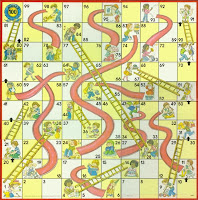Gamesmanship in Process Implementation
Remember the childhood game, “Chutes and Ladders”? We’ve actually used the elements of this game with a group of 200 scientists and engineers to capture how they are using one and the same process in different sites and functions globally. Yes, “Chutes and Ladders”!
 The task is not to discuss changing or improving the processes. The challenge is simply to identify and describe the ways in which technical leaders and their business partners around the world use different tactics or behaviors to operationalize one and the same process. This is more difficult that it may seem – simply describing actions and behaviors; the tendency again and again is to suggest what’s wrong with the process or a particular protocol.
The task is not to discuss changing or improving the processes. The challenge is simply to identify and describe the ways in which technical leaders and their business partners around the world use different tactics or behaviors to operationalize one and the same process. This is more difficult that it may seem – simply describing actions and behaviors; the tendency again and again is to suggest what’s wrong with the process or a particular protocol.
For example, the need for coordinated in-country strategies that interface well with the respective cultural as well as market realities of a particular region is one such “process”. Working in break-out groups, each group documents the “ladders” which represent ways in which one could accelerate or “cut a few corners” as well as “chutes” which represent traps, pitfalls, or other liabilities which result in going backwards.
The outcome is not playing a game; rather a graphic representation is made visible of how leaders actually work one and the same process.

Knowing there are “chutes” and “ladders” in every organizational system reflects an understanding of “gamesmanship” that also exists, for better or worse. Knowing when it is O.K. to “break the rules” and when one ought to “follow the leader” is a kind of political skill. It can be cultivated if acknowledged. Both are necessary if innovation is to thrive.

Interesting points you’ve made here. I believe this is a real organizational phenomenon. In the long run these “game moves” can foster creativity and innovation
assuming the actions are “ethically and legally” sound. It is form of political savvyness.
My challenge is the “rule-breaking” aspect of this. Rules have different meanings in different cultures. For some, rules are guidelines. For others, rules are non-negotiable. Leaders with multi-cultural, multi-ethnic teams will need to address this. How and when should get addressed? Post-project reviews? performance discussions? Never?
Most importantly, the game must be played “fair”. Ever employee has equal access to the game’s instructions and rules before he or she starts to play.
Great questions, Deary! “Rules” have different meanings not only in different cultures but within the SAME organization! Within the last few weeks I have talked with some R&D; project leads who understand the their stage gate process as a required set of boxes to be “checked” as they approach each target. Others, in the very same organization, see the “checklists” only as guidelines for what is intended, whether every box is checked or not.
What one manager or one project lead sees as a guideline another thinks is a rule. This is inevitable no doubt. But do we talk about???
In any social group, an essential skill is learning the “rules” for interactions. Those that conform with group norms, those that challenge them, and those that allow the individual to “bend” but not break the system. Corporations in general, and creative organizations in particular are no exception.
Experimentation is one approach to learning the “rules”. A more powerful one may be mentoring, or better still, experimentaion combine dwith mentoring. Mentors provide a basis of experience with normative behavior. They can also help calibrate just how much in bending and how much is breaking the rules. Healthy organizations actively encourage and support mentoring as a way of speeding learning.
This approach was used by the Obama campaign to gain the nomination. See report:
“Strategy Was Based On Winning Delegates, Not Battlegrounds”
By Jonathan Weisman, Shailagh Murray and Peter Slevin
Washington Post Staff Writers
Wednesday, June 4, 2008; A01